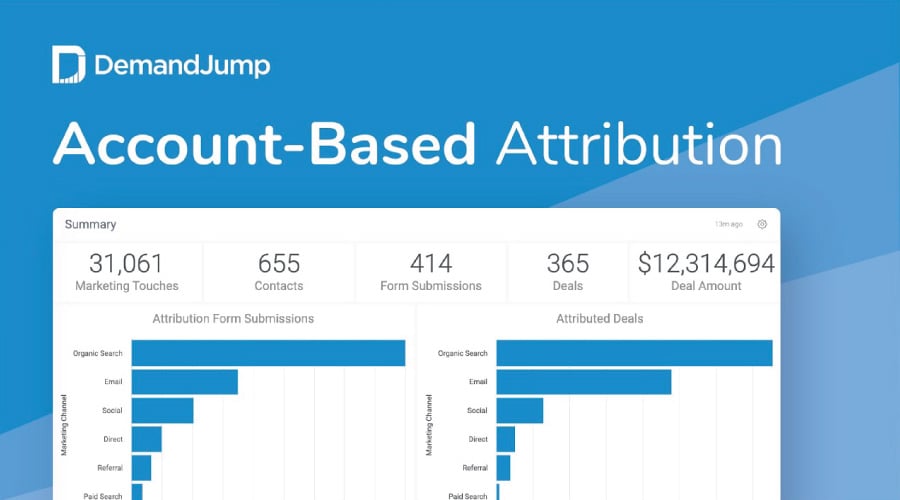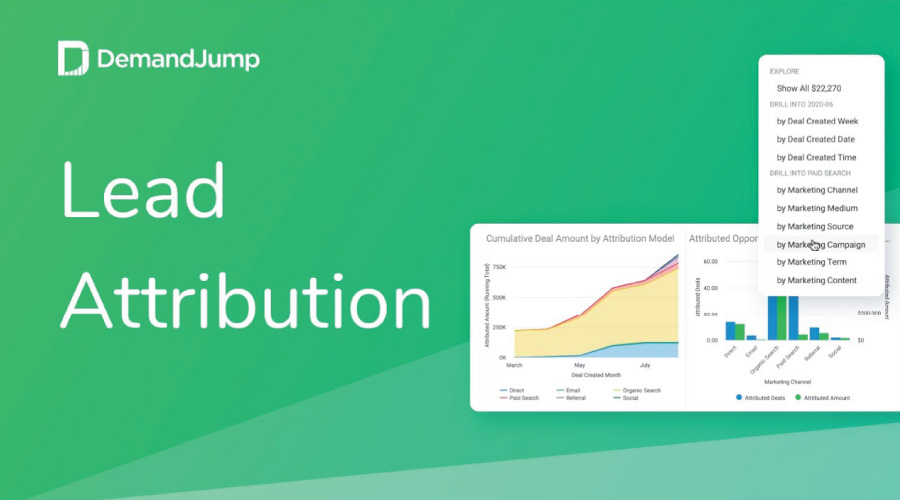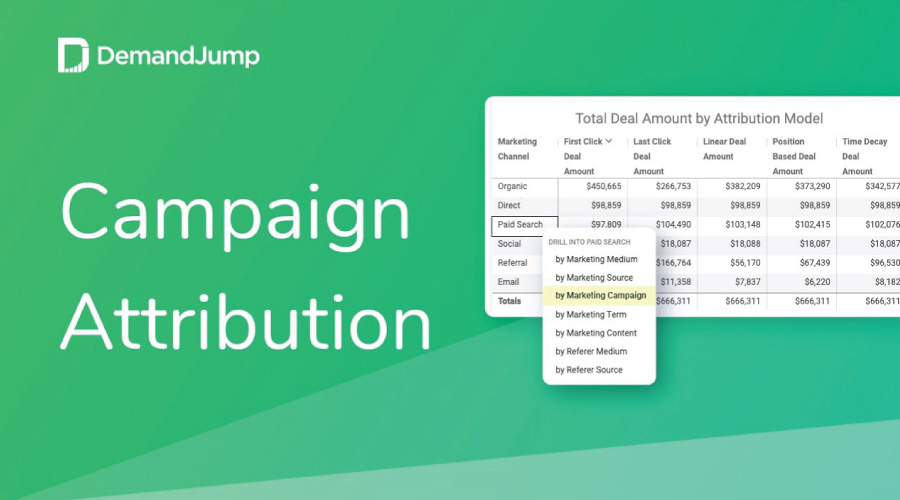Marketing Attribution
By embracing DemandJumps approach to SEO, we have been able to increase our organic rankings within just 2 weeks of implementing recommendations. This helped us see a 22% increase in organic search month-over-month.
Robert Jacko Vice President Digital Marketing @ Homage
DemandJump has become a crucial extension of our marketing team, providing game changing insights to fuel and propel all aspects of our digital marketing efforts. The DemandJump platform is a must have, we are seriously impressed.
Tim Lavinder Director of Ecommerce @ Hotsox
We used to spend hours looking for insights in dozens of tools and reports. Now we log into one place to find out what customers are doing and how to meet them where it matters most.
Zach Roop Digital Marketing Manager @ Dometic
We use DemandJump recommendations as our digital to-do list. We love going in and seeing the recommendations and knowing what to do next.
JoLynda Wilson Marketing Director @ IWC
Our Customers Love Attribution






Account-Based Attribution
Eliminate wasted time and spend. With DemandJump's automated account-based attribution
solution you will know with certainty which efforts are driving ROI.
Measure Your Marketing Performance
Find out which of your marketing efforts are making the biggest impact. See which channel drove consumers to you, the pages they visited, and all touchpoints along their path to purchase.
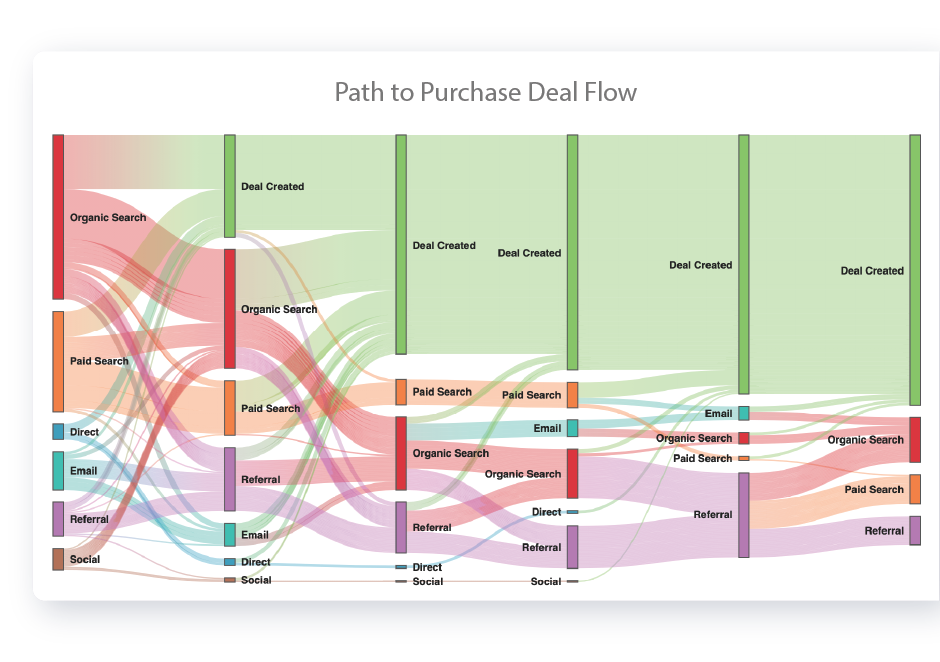
From Marketing Spend to Actual Pipeline Value
When a lead becomes a customer, you need to know which marketing channel or campaign should receive credit, and account-based attribution will give you the answers.
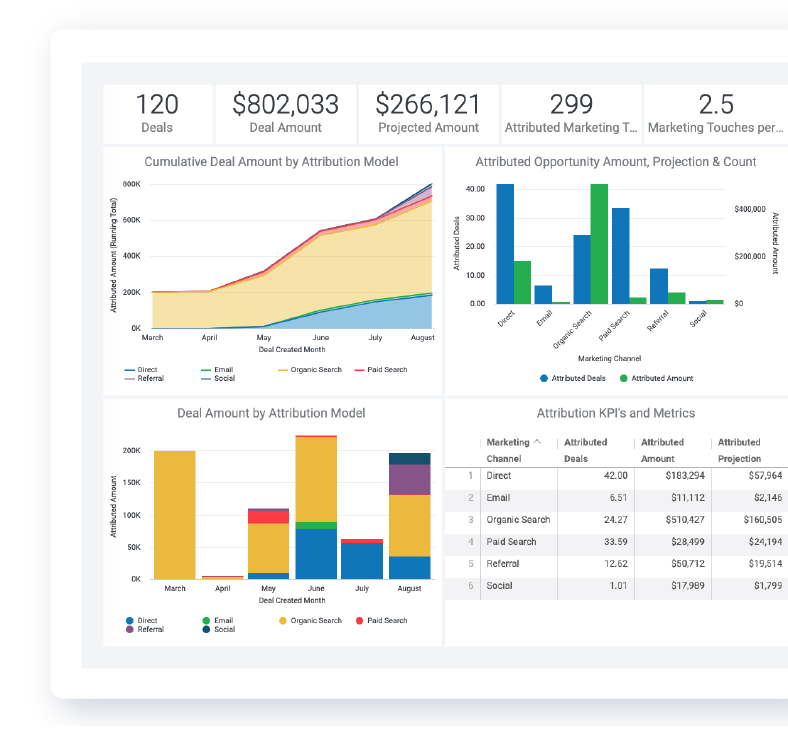
Organic & Paid Search Keyword Attribution
Beyond channel, campaign, and content attribution, you will finally see which organic and paid keywords are generating deal and opportunity revenue.
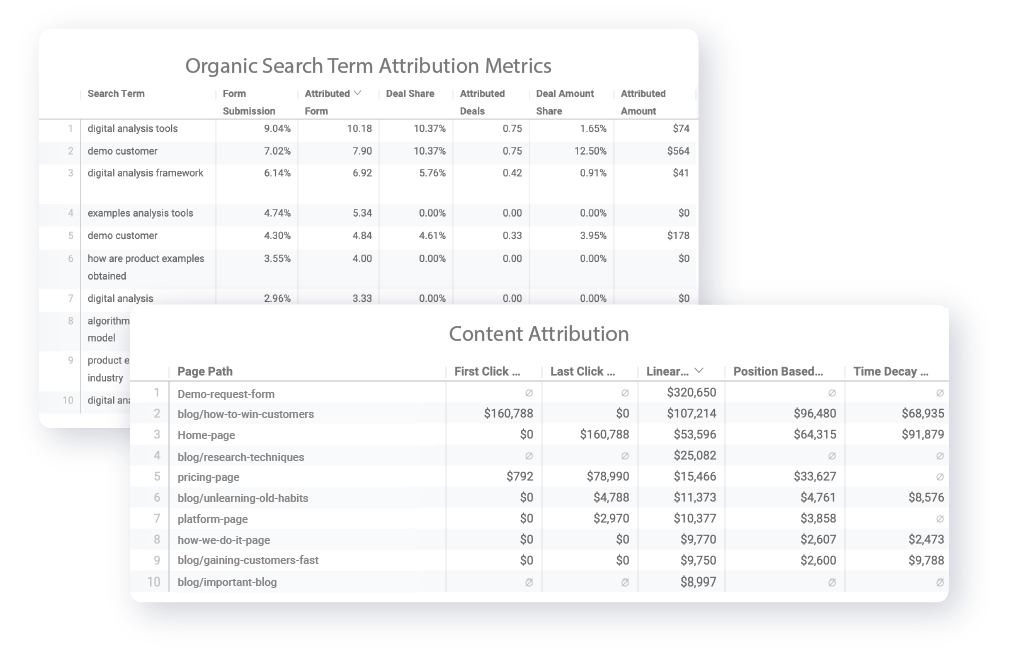
See a Demo of Attribution
Marketing Campaign Influence
Optimizing Your Marketing Spend With Attribution Insights
Making the right marketing decisions with intelligence and confidence is more important now than ever before. You need to know how to measure the results of your marketing campaigns and identify which campaigns are driving revenue. These data-driven insights give you a greater understanding of where you should spend your marketing dollars to optimize your spend and return on investment (ROI). The most effective weapon in answering these questions is to accurately measure campaign performance.
Right now marketers have more data and tools than they know what to do with, but they’re still not getting the insights they need to reach their target customer at precisely the right moment when it matters most. DemandJump takes the guesswork out of digital marketing and removes blind spots by revealing more of the Customer Journey and Competitive Landscape than ever before.
With product features like Consumer Insights, Market Intelligence, Cross-Channel Analytics, Marketing Attribution, and Channel Optimization Recommendations, the DemandJump platform allows you to:
- See what consumers are doing and identify the parts of the journey you can’t see - the websites they visit, the searches they conduct along their path to purchase before they even get to you, or more importantly, your competitors.
- See what your competitors are doing - where they are showing up, what is successfully driving their traffic, the content and ads they use, and how your marketing strategy compares.
- See what you should be doing next - so you know how to get more out of every asset, from content marketing to media spend.
What You Need to Know About Campaign Influence
The most innovative marketers are using something called campaign influence to measure what works and what doesn’t. By measuring the results of a marketing campaign and campaign conversions, this helps marketers make better decisions with future campaigns. Using campaign influence is a strategy that not only reveals which marketing campaigns lead to closed won revenue, it also reveals exactly where in the customer journey those touchpoints are most effective.
A critical aspect of developing an effective marketing strategy is knowing which campaigns are driving the best return on investment (ROI). Armed with more insightful data means you can allocate resources more effectively to acquire new customers and plan for future growth. Yet despite this, many companies fly blind by not properly assigning credit to all the touchpoints along the customer journey.
How Can You Measure Campaign Attribution?
Savvy marketers use campaign attribution to measure campaign influence as it relates to the customer’s journey. Campaign attribution demonstrates how campaigns generated revenue by influencing prospects to buy. This means measuring benchmarks by taking a deep dive into the intricacies of campaign influence by asking questions that matter to the campaign.
- How effective was the AdWord and retargeting campaign in driving revenue?
- How much influence did a social media post have on conversions?
- Did the conversions come from Search Engine Optimization (SEO) or Pay Per Click (PPC)?
By asking questions like these, the answers give you greater insights into what strategies worked best. If you are unable to get to these answers with your current data, you may benefit from using an attribution solution.
Cross Channel Campaigns
Cross-channel marketing campaigns come down to engaging with your target audience across multiple digital channels and devices. Today’s consumer moves seamlessly from their inbox to social networks, then to the web, using multiple devices such as PCs, laptops, tablets, and smartphones. They fully expect marketers to meet them wherever they are on their journey. They also expect marketing messages to be personalized and relevant to their tastes and preferences. They want the engagement to be easy to understand, use, and allow them to navigate seamlessly to what interests them most using their preferred device.
Cross-channel marketing campaigns allow marketers to employ multiple marketing channels such as:
- Mobile Marketing
- Email Marketing
- PPC and Other Online Advertising
- Website (including content marketing/blogging)
- Direct Mail
- Mail-Order Catalogs
- Retail Storefronts
Cross-channel advertising and retargeting campaigns are often more effective because campaign conversions rarely happen on the first-touchpoint. Marketing across multiple channels provides more opportunities to convert a consumer on their path to purchase. This added complexity makes it difficult for marketers to provide an engaging and seamless experience for the consumer.
It’s even more difficult to track and monitor the actions and movements of your target audience and use campaign attribution modeling to reveal insights into which efforts carry more conversion influence. It’s also difficult to ascertain exactly when in the customer journey those efforts are most effective. This is where it is helpful to take advantage of multiple attribution models. Some models are better equipped for campaign attribution than others, so now we will dive deeper into those different models.
Marketing Attribution Models
Marketing attribution models assign credit for conversions or revenue to marketing campaigns. This person-centric approach is why attribution models are more typically applied to digital campaigns than those conducted offline, such as print advertising.
The most effective attribution models will provide insight into:
- The influence of message sequencing
- The messages a consumer was exposed to and on what channel
- Which messaging gets the best result?
- Which touchpoint had the greatest impact on their decision to purchase?
To find answers to those important questions, marketers need to embrace multi-touch attribution marketing models to effectively manage, optimize, and scale campaign performance. But, what if you don’t know which attribution model is best for your business? The wrong attribution model could assign credit to only one channel when the consumer had multiple touchpoints, possibly leading you to ignore other higher-performing channels.
Before picking a marketing attribution model, it is smart to consider the industry in which you work. Each industry has differing sales cycles, so it is important to pick a marketing attribution model that aligns with the consumer purchasing journey most common in your market and industry. Oftentimes it is best practice to use multiple attribution models to get a comprehensive look at how each of your channels influences conversions.
Although there are dozens of possible attribution models, they can generally be narrowed down into three categories.
1. Single-Touch (e.g. first/lead-creation touch, last/opportunity-conversion touch)
2. Multi-Touch Attribution (e.g. W-Shaped or Linear)
3. Full-Path (which includes post opportunity stage marketing)
Single-Touch Attribution Models
The Single-Touch Attribution Model gives 100% of the credit to a single marketing touchpoint. The single touchpoint is often the first or last one engaged with by the consumer. The First-Touch model overemphasizes the top-of-the-funnel marketing channels that drive awareness. For this reason, single-touch attribution models are less widely used today, as they fail to provide a nuanced look at the complete customer journey.
Another example of Single-Touch Attribution is the last-click model, which attributes a conversion to the last marketing touchpoint, the touchpoint that directly results in a conversion. However, this approach neglects to consider the entire customer journey. First-touch attribution assumes the consumer chose to convert after the first advertisement they encountered, therefore, giving full attribution to this first touchpoint, regardless of any additional messaging they may have seen subsequently.
Each of these methods fails to factor in the entire customer journey, therefore marketers should avoid relying solely on these attribution methods. Last-touch undervalues any awareness channels like blog posts, social media, or advertising all important in the marketing mix. These channels play a huge part in building your brand and are a valuable component of any marketing strategy. While Single-Touch Attribution models often don’t tell the full story, they still have value when used alongside a multi touch model.
Multi-Touch Attribution
It is widely believed that it takes 6 to 8 touchpoints to generate a viable sales lead. Multi-touch attribution models look at all touchpoints engaged with by the consumer leading up to a purchase. As a result, these are considered more comprehensive and depending on which multi-touch model you use, they might assign value to channels differently.
For example, some assign value based on when a consumer interacted with a touchpoint relative to the conversion, while others weigh all touchpoints equally. These models are largely differentiated by how they divide credit between touchpoints on the path to purchase.
Full-Path Attribution
Full-Path Attribution models, also known as Z-Shape models, give you insight into all touchpoints throughout the customer journey. This model is also known as a position based model because it attributes different percentages of the conversion to each touchpoint based on where it fell in the path to purchase.
Common Attribution Errors and Factors That Influence Attribution
In designing your campaign, be mindful of these common campaign attribution errors and factors that influence attribution.
- Not Being People-Focused - People-based marketing takes a more personal approach to marketing, allowing your brand to customize messaging and deliver campaigns at optimal times. Make sure you focus on each consumer as a unique target, instead of segmenting them into broad audience groups.
- Flawed Methodologies - Marketers are quick to focus on CPMs, CTR, and other metrics implementing an "easy button" instead of using attribution models required to measure actual ad effectiveness in a statistical setting.
- Offline Marketing - While digital channels are popular, many conversions still occur offline. Despite this, many advertisers only factor online sales and touchpoints into their attribution models simply because it’s easy to tie online spend to online actions.
- Location Gaps - Most models don’t take into account a consumer’s distance to a store location therefore targeting them is different to targeting a consumer who needs to shop online.
- Cookie Crumbles - Not the chocolate chip kind! A percentage of internet users regularly clean their tracking cookies and NAI guidelines require cookies to expire after 30days. This can mean recent ad exposures appear to be more impactful than they really are.
Google Ad Campaign Types
Advertising with Google Ads starts with creating a campaign based on your advertising goals. For example, if you'd like to show ads on Google.com to get more visitors to your website, you should choose a Search Network campaign. Each advertising network has different types of campaigns to choose from that should be aligned with your goals. You can select a goal for your campaign based on the actions you’d like your customers to take such as download a free ebook, click on the advertisement, call you, or visit your website as an example.
You can also select a campaign type, such as Search Network, Display Network, Shopping, or Video. You’ll then see recommendations within the app for features and settings that will help you meet your campaign's main advertising objective. Keep in mind that all campaign settings and features will be available to you despite what goal you choose, and you can always make a change to your goal, or choose not to use a goal.
Goals could include:
- Sales
- Leads
- Website Traffic
- Product & Brand Consideration
- Brand Awareness & Reach
- App Promotion
Choosing a specific campaign type determines where customers will be able to see your ads, but you make this more specific by targeting your ads.
Campaign types include:
- Search Network Campaign
- Display Network Campaign
- Shopping Campaign
- Video Campaign
- App Campaign
Common Google Ads Attribution User Mistakes
Google Ads mistakes can derail your data collection strategy and become very costly to get the outcomes you want. Here are four of the most common attribution mistakes when using Google Analytics:
- Tag Capitalization Mistakes
- Improper Tagging Within Your Website
- Self-Referrals
- Incorrect Channel Groupings
Some mistakes are so common, like those above, that nearly all sites will make them. Some can be quickly remedied while other mistakes are quite a bit sneakier, and you may not notice them until it’s too late.
Don’t Trust Your Data
It’s important not to trust your data blindly. You should be continually asking questions that challenge your assumptions.
Spend Enough Time On Strategy
Time is money we know, but not spending enough time on your overarching marketing strategy can lead to costly mistakes. While trying to get things done, it’s important for someone to challenge the strategy with questions, “ Are we aligned with consumer behavior?” or “ Are we answering the right questions?”
Diving In Too Quickly
Diving in too quickly when setting up Google Ads can backfire on you if you rush into a campaign too quickly without much forethought. Google Ads mistakes are usually macro-level details dealing with how you approached tracking and analysis in the first place. Conquering this aspect before placing Google Ads means your attitude, knowledge, and approach will naturally fall into place.
Not Automating Reports
Wherever you can, automate reports within Google Ads to eliminate human error. Anytime you are completing a task manually that can be automated, you are wasting precious resources and leaving yourself open to error.
Not Using Google Tag Manager
There’s simply no reason to hard code Google Analytics onto your site. Google Tag Manager is free, and you can use it to organize your tags, including Google Analytics. Installing Google Analytics using Google Tag Manager will open up further opportunities for advanced tracking down the line as well.
Remain open to change throughout the entire lifecycle of any marketing campaign as the modeling you are using today may need to be adjusted as campaigns evolve in the future.
Be confident that you're making the best marketing decisions for your business. Request your 30-day free trial of the DemandJump platform today to understand more about how to optimize your marketing spend using automated attribution modeling.
Marketing Attribution Resources
Marketing AttributionAttribution Tracking
B2B Marketing Attribution
Hubspot Attribution
Marketing Campaign Influence
Mobile Attribution
Multi Touch Attribution
Offline Attribution
Sales Forecasting
Sales Opportunity Attribution
The Future of Data-Driven Marketing
Opportunities of Internet Marketing
Other Resources
Channel Optimization
Consumer Behavior
Consumer Insights
Consumer Insights and Analytics
Competitor Analysis Tools
Content Marketing
Content Strategy
Cross-Channel Analytics
Customer Insight Research Techniques
Customer Journey Map
Market Intelligence
Marketing Analytics Techniques
Market Research
Marketing Attribution
Opportunities of Internet Marketing
Types of Consumer Insights



